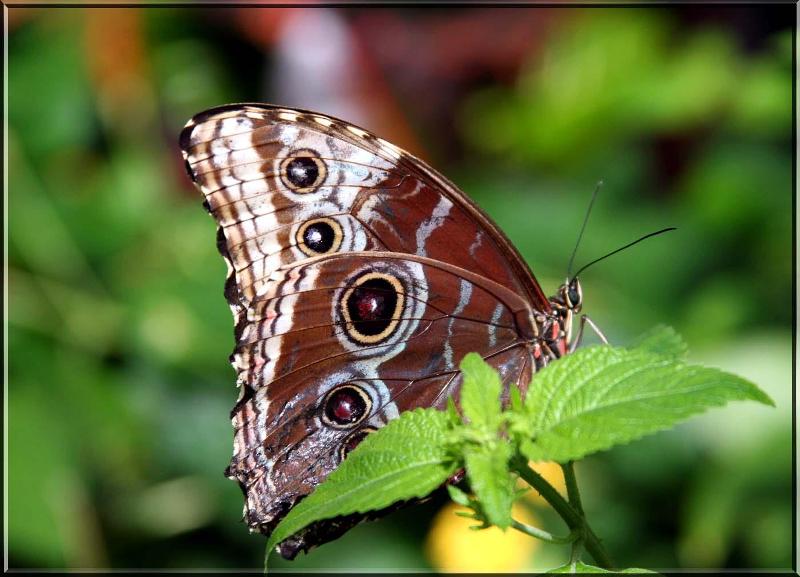 Owl butterflies, of which there are around 20 different species, are members of the genus Caligo, in the brush-footed butterfly family Nymphalidae. They are found in the rainforests and secondary forests of Central and South America.
Owl butterflies, of which there are around 20 different species, are members of the genus Caligo, in the brush-footed butterfly family Nymphalidae. They are found in the rainforests and secondary forests of Central and South America.The name is derived from the presence of large "eyespots" (ocelli) on the underside of the hindwings. To a human observer of dead butterflies pinned up in a collection, owl butterflies' underwings resemble the head of an owl when the butterfly is held head down. It was speculated that the ocelli are "false eyes" to scare smaller birds that attempt to prey on the butterfly.
There is no evidence that the function of the ocelli is to resemble an owl. The position in which the owl-like appearance occurs is not generally assumed by the butterfly in life. In its resting position, Calico settle down with closed wings like most butterflies, showing only one of the eyespots, and do not look owl-like.
The actual significance of the ocelli remains elusive (Stevens 2005). In some butterflies, particularly Satyrinae (such as the Gatekeeper Butterfly and the Grayling), it has been shown that ocelli serve as a decoy, diverting bird attack away from the vulnerable body, and towards the outer part of the hindwings or the forewing tip. Owl butterflies have been observed with large chunks missing from their hindwings[citation needed]. On the other hand, decoy ocelli are almost always small and located near the margin of the wing, where the damage caused by a bird's beak would interfere little with the butterfly flying and going about its life. The position and size of the owl butterflies' ocelli makes them a decidedly suboptimal decoy, as they are far too close to the abdomen in resting position to ensure no substantial damage is inflicted by a bird snapping at them.
The underwing pattern is highly cryptic. They rest on tree trunks and large branches, and at least to human observers, when seen from a distance the eyespot and the surrounding dark area do not compromise their superb camouflage. As many birds are able to see in the ultraviolet, more research is needed to determine how the eyespot pattern is perceived by the actual predators. In any case, at fairly close range the most visible thing about a resting owl butterfly is certainly a dark patch containing a single "false eye".
Owl butterflies are very large, and fly only a few metres at a time, so avian predators have little difficulty in following them to their settling place. However, the butterflies preferentially fly around dusk, when few avian predators are around. Indeed, their main predators are apparently small lizards such as Anolis. It was suggested that the hindwing underside pattern actually resembles the head of a large a large Hyla tree frog, which prey on Anolis. This theory remains to be tested. It is known that many small animals hesitate to go near patterns resembling eyes with a light-colored iris and a large pupil, which matches the appearance of the eyes of many predators that hunt by sight. Thus, it is conceivable that the pattern is a generalized form of automimicry that would buy the butterfly time to escape from an approaching predator.


No comments:
Post a Comment